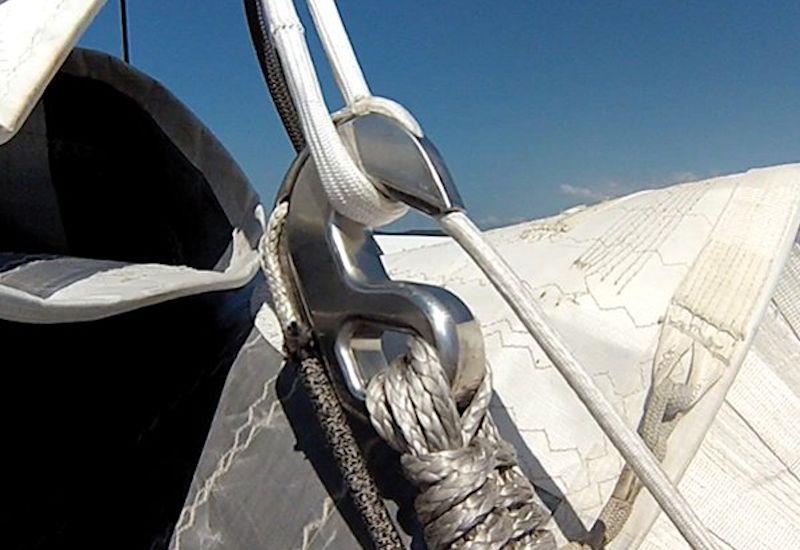
Andy Rice talks to Nick Black about Main Halyard Locks
by Andy Rice 14 Jan 2019 09:00 UTC

Karver Reef Hook © Karver
The final in our series on lock systems for sailing yachts, Andy Rice talks to Nick Black of Rigging Projects about mainsail locks.
REEF LOCKS:
Reef locks have taken off in a big way in recent years, mostly because the clew loads have become higher and higher on all the larger boats now coming out. But, they don't just apply to the big end of the market; reef locks are of interest to anyone running a boat weighing more than approx. two tones. Anything above a 30-footer could benefit from reef lock technology.
Reef locks mean you can use very small lines in the reefing system, so that's a big weight savings right there. You don't need big clutches or jammers inside the boom, and it also takes compression loads out of the boom, which admittedly only becomes interesting when you get a long way up the size range. Let's look at the two main options - external and internal:
External Reef Locks
Facnor and Karver use external locks which are very easily retrofitted. They work in a claw-like mechanism where you basically get a loop or a shackle. A cup gets pulled down through the reef line and as the clew gets closer and closer, just pops over the mechanism. Then you have a strap around the boom that holds the locking mechanism in place. So those ones lend themselves very easily to retrofitting.
INTERNAL BOOM LOCKS:
Southern Spars and Hall Spars offer internal boom locks, which are aimed more at the racing or high-performance cruising end of the market and these are quite expensive. The most elegant solution is an internal lock with a bullet. But the costs are probably about five times the price compared with an external option.
What does it cost?
For a 60-footer, the Facnor or the Karver product would cost somewhere around 800 to 1000 euros per unit. And the retrofitting process is really as simple as just adding either a dogbone pin in the boom to hold the lock in position or putting a strap around the boom - and that's it.
If you were to install an internal lock on a 60-70-footer, you'd probably be looking at somewhere in the realms of 4,000 euros for the lock system itself. Then you must do all the installation and extra patching into the boom which is probably around 6,000 to 6,500 euros per retrofit. The nice thing about internal is there's less hardware hanging around on the sail. Apart from the aesthetic benefits, the main advantage of internal is increased performance; more seamless, less windage and less hardware.
GAFF LOCKS:
Square-top mainsails have become popular in the last decade. These big square roaches have resulted in a lot of performance cruisers now having separate top mast backstays going to each side of the boat. So, you end up with this huge, three to four metres of square-top mainsail - which needs some way of engaging it into the headboard car, prior to hoisting. In the past, it meant a couple of people having to go up the rig, with various people hoisting halyards and getting everything in the right position and trying to locate a pin into the headboard. It could be quite a hassle.
However, there are now various solutions designed to deal with square tops, from the likes of Southern Spars, Hall Spars, Karver and one from my own company, Rigging Projects. Most of the other options involve some form of a hoist line to engage the headboard into the car, which is separate to the main halyard hoisting mechanism. But Rigging Projects have developed a version called the RPG (Rigging Projects Gaff lock) which is just the same process as hoisting the main halyard on a standard pin-head mainsail. As you start to pull the main halyard the headboard is automatically brought off the boom and onto the headboard car and hoisted up the mast. To disengage the system, you simply drop the mainsail down and once all the batten stacks gather at the bottom of the mast, - the headboard automatically comes off the car. The RPG simplifies an otherwise complicated process, and we're proud to have won a 2017 DAME Award Nomination for this product.
If you have any questions about lock systems, then please feel free to contact us at or complete our halyard lock enquiry form.
About the Authors
Co-owner of independent rigging company, Rigging Projects, Nick Black is one of the most sought-after riggers in the business. One way or another Nick's work has made its way into most of the top tiers of the sport - the America's Cup, Volvo Ocean Race, Vendée Globe, the grand prix circuits like the TP52s, and in the superyacht scene.
Andy Rice is a UK-Based European and National Title holder for various types of Racing boats. He started his career in yachting journalism in 1992, writing for Seahorse Magazine. Rice now works as a journalist and copywriter for many different clients and magazines. In between his Sailing Intelligence commitments, he still manages to write regular columns for Seahorse, ShowBoats International, Yachts & Yachting and Boat International.